Energy & Environment
The Solar Surge: India’s Bold Leap Toward a Net Zero Future
Posted On:
19 AUG 2025 5:25PM
"Green Future, Net Zero" aren't just fancy words but reflect India's need and commitment, making it the best destination for investment and innovation in renewable energy.[1]
- Prime Minister Narendra Modi
August 18, 2025
- India ranks 4th globally in Renewable Energy Installed Capacity, 4th in Wind Power, and 3rd in Solar Power capacity, (IRENA RE Statistics 2025)
- India made 1,08,494 GWh of solar power, more than Japan’s 96,459 GWh, and became the world’s third-biggest solar energy producer.
- India’s solar module manufacturing capacity jumped from 38 GW to 74 GW during FY 2024–25.
- Renewables now make up 50.07% of India’s total installed power capacity of 484.82 GW – a COP26 commitment achieved five years ahead of the 2030 target
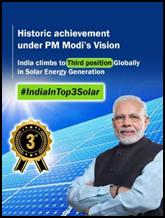
Just a decade ago, India’s solar landscape was in its infancy, with panels dotting only a few rooftops and deserts. Today, the nation has raced ahead to script history: India has officially surpassed Japan to become the world’s third-largest solar power producer. According to the International Renewable Energy Agency (IRENA), India generated an impressive 1,08,494 GWh of solar energy, leaving Japan behind at 96,459 GWh[2].
India’s cumulative solar power capacity stood at 119.02 GW as of July 2025. This includes 90.99 GW from ground‑mounted solar plants, 19.88 GW from grid‑connected rooftop systems, 3.06 GW from hybrid projects, and 5.09 GW from off‑grid solar installations, reflecting the country’s diverse approach to expanding renewable energy.[3]
India’s progress in the renewable energy sector reflects the country's focused policies and strategic planning under national leadership. As part of the pledge made at COP26, efforts are being directed towards reaching the target of 500 GW of non-fossil fuel electricity capacity by 2030. This commitment is seen as a key step in India's clean energy transition and its broader climate goals.
Record Surge in India’s Solar Capacity
India lies in the tropical region, with the Tropic of Cancer passing through many states. This gives the country a high potential for solar power generation. The total solar sector potential of the Indian continent is 748 GW. States/ UTs like Rajasthan, Jammu and Kashmir, Maharashtra, Madhya Pradesh, and Andhra Pradesh have some of the highest solar potential in the country, making them key drivers of India's clean energy growth.[4]
|
Region
|
Major High‑Potential States
|
|
Northern & Western
|
Rajasthan, Gujarat
|
|
Southern & Central
|
Karnataka, Tamil Nadu, Andhra Pradesh
|
|
Eastern & Other
|
Maharashtra, Chhattisgarh, Odisha[5]
|
In July 2025, India’s solar power capacity had increased by 4,000%, and the country’s total renewable energy capacity reached 227 GW. Palli village in Jammu & Kashmir became a notable example, emerging as India’s first carbon-neutral panchayat by running entirely on solar power. Emphasis was placed on the need for energy storage and adoption of new technologies to meet future energy demands. Government schemes like the PM Surya Ghar Yojana and PM Kusum Yojana are playing a key role in helping households and farmers transition to clean solar energy[6]
Boost in Domestic Solar Manufacturing
India’s solar manufacturing sector includes key components like solar modules, solar PV cells, and ingots and wafers. Producing these within the country supports the domestic economy and reduces dependence on imports. In just one-year, solar module manufacturing capacity nearly doubled—from 38 GW in March 2024 to 74 GW in March 2025. Similarly, solar PV cell manufacturing rose from 9 GW to 25 GW. A big milestone was the start of India’s first ingot-wafer manufacturing facility (2 GW), further strengthening the entire solar supply chain.[7]
This rapid growth in domestic capacity is strongly supported by government policies. To promote Indian-made solar products, the government has made it mandatory for projects under schemes like the Rooftop Solar Programme, PM-KUSUM, and CPSU Scheme Phase II to use panels and cells made in India. To make this shift more effective, a Basic Customs Duty (BCD) was introduced in April 2022 on imported solar cells and modules. This makes imports more expensive and encourages the use of Indian alternatives—boosting local manufacturing and reducing reliance on foreign suppliers.[8]
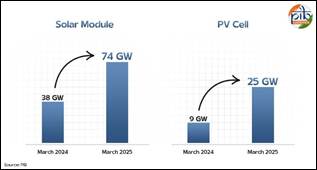
KEY FLAGSHIP INITIATIVES IN SOLAR ENERGY:
The government has launched several flagship initiatives to promote the adoption and development of solar energy across the country.
PM Surya Ghar: Muft Bijli Yojana
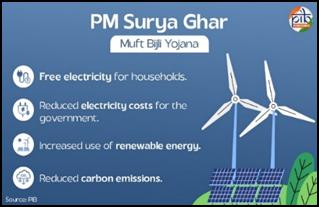
PM Surya Ghar Muft Bijlee Yojana is a central scheme with an outlay of Rs. 75,021 crores to help one crore Indian households to get up to 300 units of free electricity every month by installing rooftop solar panels. The government provides a subsidy of ₹30,000 for 1 kW, ₹60,000 for 2 kW, and ₹78,000 for 3 kW rooftop solar systems or higher. Even if a family takes a loan to install the system, they can still save about ₹15,000 every year on electricity bills after paying the monthly loan EMI.
Application Process for PM Surya Ghar is as follows:
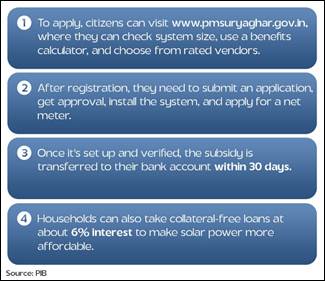
PM-KUSUM (Pradhan Mantri Kisan Urja Suraksha Evam Utthaan Mahabhiyaan)
The PM-KUSUM Scheme supports farmers in using solar energy instead of diesel. Farmers can get a 30% to 50% subsidy to install new solar pumps or convert old pumps to solar. They can also build solar power plants up to 2 MW on their own land and earn money by selling electricity to local DISCOMs. The scheme is carried out by state implementing agencies[9]. Moreover, it is aimed at ensuring energy security for farmers in India, along with honouring India’s commitment to increase the share of installed capacity of electric power from non-fossil fuels sources to 50% by 2030 as part of Intended Nationally Determined Contributions (INDCs).[10]
Solar Parks Scheme
The government is running a scheme called “Development of Solar Parks and Ultra Mega Solar Power Projects” to set up large solar power plants connected to the electricity grid, with a target of 40 GW by March 2026. So far, 53 Solar Parks with a total capacity of about 39,323 MW have been approved in 13 states. Out of these, 18 parks (10,856 MW) are fully developed, where 10,756 MW of solar power projects are already working. Another 3140 MW of solar projects are running in 8 parks (10,043 MW). In total, 13896 MW of solar power projects have started operating in 26 Solar Parks, while the remaining parks are still being developed. India’s clean energy growth isn’t just reducing carbon emissions—it’s changing lives. Large solar parks now provide low-cost electricity, while wind farms in Gujarat and Tamil Nadu meet evening power needs. Bioenergy projects are boosting rural incomes through job creation.[11]
PM JANMAN: Empowering PVTG Communities through Solar Electrification
The Pradhan Mantri Janjati Adivasi Nyaya Maha Abhiyan (PM JANMAN) was launched to address the development needs of Particularly Vulnerable Tribal Groups (PVTGs) through 11 critical interventions across 9 Ministries. A key initiative under this mission and Dharti Aaba Janjatiya Gram Utkarsh Abhiyan (DA JGUA) is the New Solar Power Scheme, with an outlay of ₹515 crore, aimed at electrifying one lakh un-electrified households in Tribal and PVTG habitations across 18 states, promoting inclusive growth and sustainable energy access in remote tribal areas.[12]
Increase in Solar PV Manufacturing Capacity[13]
Since 2014, India’s capacity to make solar PV cells has grown about 21 times, going up from 1.2 GW in 2014 to about 25 GW by March 2025. Similarly, the capacity to make solar PV modules has grown more than 34 times, rising from 2.3 GW in 2014 to about 78 GW by March 2025
Other Important initiatives
The Omkareshwar Floating Solar Park in Madhya Pradesh is one of Asia’s largest floating solar parks, with a planned capacity of 600 MW. It costs ₹330 crore, with ₹49.85 crore support from the Centre. These solar projects are set up on water bodies to save land and work more efficiently.[14]
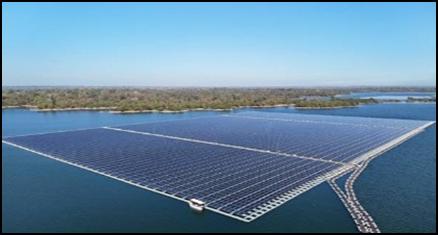
Agrivoltaics use solar panels and allow farming underneath, increasing land use and farmer income. Projects like the Sun master Plant in Delhi and a 105 KW system by ICAR in Jodhpur show India’s progress in clean energy.[15]
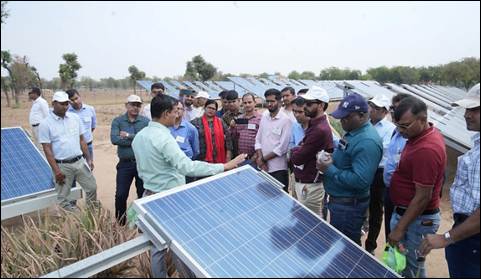
India’s Global Solar Leadership: ISA & OSOWOG
International Solar Alliance (ISA): Launched by India and France at COP21 in 2015, the ISA is a global alliance of 100+ countries working to combat climate change through solar energy. It aims to mobilise $1 trillion in investments by 2030, reduce technology and financing costs, and promote affordable solar solutions. With a special focus on Least Developed Countries (LDCs) and Small Island Developing States (SIDS), the ISA seeks to drive low-carbon growth through cost-effective and transformational energy solutions.[17]
ONE SUN- ONE WORLD- ONE GRID (OSOWOG): The ‘One Sun, One World, One Grid’ (OSOWOG) initiative, launched by India at the ISA Assembly in 2018, envisions a global solar grid under the idea that ‘the sun never sets.’ Led by ISA, it aims to connect solar resources across regions from South Asia to Africa and Europe, with studies and frameworks already underway
India’s Renewable Sector: An Overview
India’s energy sector uses many different sources to produce electricity. These include fossil fuel sources like coal, gas, lignite, diesel, etc, as well as non-fossil fuel sources like solar, wind, hydro, nuclear and biomass. India’s total power capacity has now reached around 485 GW. Out of this, 242 GW comes from thermal power, 116 GW from solar, and 51.6 GW from wind. This shows India’s strong move towards clean energy and better energy security.[18]
In the last 11 years, India has made significant progress in renewable energy. To meet the goal set at COP26, the Ministry of New & Renewable Energy (MNRE) is working to reach 500 GW of non-fossil fuel capacity by 2030.
By June 2025, India has installed 242.8 GW of non-fossil fuel installed capacity, including 233.99 GW of renewable energy and 8.8 GW of nuclear power. This now makes up 50.07% of the country’s total power capacity of 484.82 GW. Renewable energy alone has grown almost three times, from 76.37 GW in 2014 to 233.99 GW in 2025, showing a strong move toward a cleaner and sustainable future.[19]
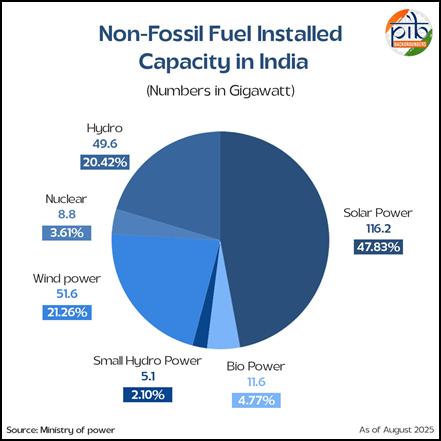
India added a record 29.52 GW of renewable energy in FY 2024–25, boosting total clean power capacity to 220.10 GW, up from 190.57 GW last year. This progress brings India closer to its goal of 500 GW non-fossil capacity by 2030, in line with the “Panchamrit” climate targets set by the Prime Minister.[20]
India stands 4th globally in Renewable Energy Installed Capacity, 4th in Wind Power capacity and 3rd in Solar Power capacity (as per IRENA RE Statistics 2025).[21]
India’s Renewable Energy Growth: 2014–2025
The renewable energy sector in India consists of solar energy, wind energy, hydro power, and bioenergy, all of which help reduce dependence on fossil fuels and support sustainable development. Installed RE capacity has grown from 76.37 GW in March 2014 to 233.99 GW in June 2025, an increase of nearly 3 times.[22]
Wind Energy
India added 4.15 GW of wind energy in FY 2024–25, taking the total installed capacity to 51.6 GW.
India ranks 4th globally in onshore wind with 52.14 GW installed (as of 31 July 2025), and 30.10 GW is under implementation[23]. Wind power generated 83.35 billion units from Apr 2024 to March 2025, contributing 4.56% to total electricity. The country has a wind potential of 1164 GW and an annual manufacturing capacity of 18 GW. Offshore wind development is guided by the National Offshore Wind Energy Policy (2015), with MNRE as the nodal ministry for projects along India’s 7600 km coastline[24].
Bioenergy
India has 11.60 GW of bioenergy capacity (including 0.55 GW from off-grid and waste-to-energy) and 5.10 GW from small hydro, with 0.46 GW under construction[25]. To support this, the National Bioenergy Programme (2021–2026) was launched with a ₹1715 crore budget, offering central financial help for setting up bioenergy projects across the country under the following components. [26]
Waste to Energy Programme (Programme on Energy from Urban, Industrial and Agricultural Wastes /Residues)
Biomass Programme (Scheme to Support Manufacturing of Briquettes & Pellets and Promotion of Biomass (non-bagasse) based cogeneration in Industries)
Biogas Programme (Programme to support setting up of small (1 m3 to 25 m3 biogas per day) and medium size Biogas plants i.e., above 25 m3 to 2500 m3 bio gas generation per day)
Biofuel (Ethanol) Blending
India is now the world’s third-largest ethanol producer and consumer. Ethanol blending in petrol increased from 10% in June 2022 to 17.98% by February 2025. The government aims to reach 20% blending by 2025–26, ahead of the earlier 2030 target[27]. This is supported through subsidies, lower GST, and long-term purchase deals. Ethanol and biodiesel, made from biomass, are key biofuels that help reduce dependence on fossil fuels for transport[28].
Hydro Energy
In India, hydro projects up to 25 MW are called Small Hydro Power. The country has a potential of 21.1 GW from 7,133 sites, mostly in hilly states[29]. India already has 5.11 GW installed, with more under development. Large hydro and pumped storage projects are also growing, with 133.4 GW hydro and 181.4 GW pumped storage potential[30]. The government supports these with benefits like tariff help and transmission charge waivers.
Green hydrogen is made by splitting water into hydrogen and oxygen using solar or wind energy. It will replace fossil fuels in industries like steel and transport, and provide long‑term clean energy storage. The demand for green hydrogen is growing fast because it can help reduce emissions and pollution in many areas like transport, shipping, and steel production. It can take the place of petrol and diesel in vehicles, which are big causes of harmful emissions. In factories, green hydrogen can be used to make things like ammonia, methanol, and steel, which now depend a lot on fossil fuels. It can also store energy and act as a backup for solar and wind power, making sure there’s always a steady supply of clean energy.[31]
The National Green Hydrogen Mission was launched by the Government of India to cut carbon emissions and make India a global leader in green hydrogen. By 2030, the goal is to produce 5 million tonnes of green hydrogen every year, bringing in ₹8 lakh crore investments, creating 6 lakh jobs, and saving ₹1 lakh crore in fossil fuel imports. The mission focuses on production, pilot projects, electrolyser manufacturing, skill training, infrastructure, and research, with plans to replace fossil fuels in steel, transport, and fertilizer sectors.[32]. To push this forward three major ports namely Kandla, Paradip and Tuticorin ports have been identified by Ministry of Ports, Shipping and Waterways (MoPSW) to be developed as Green Hydrogen hubs.[33]
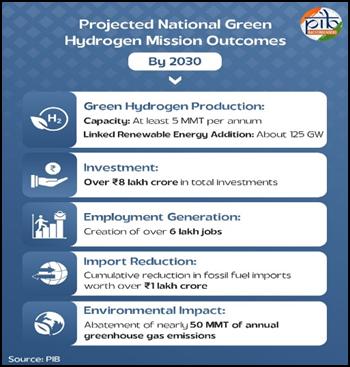
|
On July 16, 2025, Union Minister Prahlad Joshi reaffirmed India’s 500 GW non‑fossil capacity goal by 2030. The Cabinet cleared a ₹7,000 crore exemption for NLC India Ltd to strengthen its renewable arm, NLC India Renewables Limited (NIRL). This step will speed up big solar and wind projects, with NIRL set to expand from 2 GW now to 10 GW by 2030 and 32 GW by 2047, supporting India’s COP26 and net‑zero targets.[34]
India focuses on five key priorities to achieve its 2030 target of 500 GW non-fossil capacity.[35]
- Better Contracts: Long-term power deals to attract investors.
- Stronger Grids: Modern grids and battery storage for steady power supply.
- Make in India: Boosting local production of solar panels and wind turbines.
- Smart Land Use: Using land wisely with floating solar and solar on farms.
- Easy Financing: Making funds available to support clean energy projects.
|
India’s rapid transition to clean energy is positioning the country ahead of schedule in meeting its Paris Agreement commitments. By accelerating the growth of non-fossil fuel capacity, India is enhancing energy security, reducing coal imports, creating jobs, and strengthening reliable power supply. This progress underscores India’s leadership role in the global fight against climate change[36].
The Paris Agreement was adopted under United Nations Framework Convention on Climate Change (UNFCCC) in 2015[37]. Under its Paris Agreement Nationally Determined Contributions (NDCs), India committed to reducing carbon intensity of the economy by 45% by 2030, over 2005 levels and the target of achieving 50% of cumulative electric power installed capacity from non-fossil fuel-based energy resources by 2030is now being met ahead of schedule[38].
Conclusion
India is moving strongly towards a green future. After crossing 100 GW of solar power, the country is on track to reach 500 GW of clean energy by 2030and net-zero by 2070. Projects like large solar parks, rooftop solar, and the PM Surya Ghar Muft Bijli Yojana are helping households become self-reliant in energy.
India has reached a significant milestone—50% of its installed electricity capacity now comes from non-fossil fuel sources, achieving these five years early against its Paris Agreement goal. This shows that development and sustainability can go hand in hand. India’s energy journey over the past decade reflects a strategic shift towards self-reliance, sustainability, and innovation. From green hydrogen to solar rooftops, rural electrification to digital procurement, every initiative underscore India’s vision of inclusive, secure, and clean energy for all. As the nation moves forward, its balanced and forward-looking energy strategy continues to power economic growth and a sustainable future.
REFERENCES
CMO GUJARAT
https://cmogujarat.gov.in/en/latest-news/pm-shri-narendra-modi-inaugurates-4th-global-renewable-energy-investors-2024-summit-and
INDIA BRAND EQUITY FOUNDATION
https://www.ibef.org/news/india-becomes-third-largest-solar-energy-generator-union-minister-of-new-and-renewable-energy-mr-pralhad-joshi
MINISTRY OF NEW AND RENEWABLE ENERGY
https://mnre.gov.in/en/physical-progress/
https://mnre.gov.in/en/production-linked-incentive-pli/
https://mnre.gov.in/en/notice/new-solar-power-scheme-for-pvtg-habitation-villages-under-pm-janman/
https://mnre.gov.in/en/wind-overview/
https://mnre.gov.in/en/off-shore-wind/
https://mnre.gov.in/en/hydrogen-overview/
https://mnre.gov.in/en/small-hydro-overview/
https://pmkusum.mnre.gov.in/#/landing
PIB
https://www.pib.gov.in/PressReleasePage.aspx?PRID=2117501
https://www.pib.gov.in/PressReleasePage.aspx?PRID=2143701
https://www.pib.gov.in/PressNoteDetails.aspx?NoteId=154545&ModuleId=3
https://www.pib.gov.in/PressReleasePage.aspx?PRID=2090177
https://www.pib.gov.in/PressReleasePage.aspx?PRID=2120941
https://www.pib.gov.in/PressReleasePage.aspx?PRID=2120729
https://www.pib.gov.in/PressReleasePage.aspx?PRID=2113234
https://www.pib.gov.in/PressReleasePage.aspx?PRID=2129952
https://www.pib.gov.in/PressReleaseIframePage.aspx?PRID=2079832
https://www.pib.gov.in/PressReleasePage.aspx?PRID=2145148
https://www.pib.gov.in/PressReleasePage.aspx?PRID=2144627
https://www.pib.gov.in/newsite/PrintRelease.aspx?relid=175438
https://www.pib.gov.in/PressReleasePage.aspx?PRID=1795071
https://www.pib.gov.in/PressReleasePage.aspx?PRID=2147982
https://www.pib.gov.in/PressReleasePage.aspx?PRID=2100603
https://www.pib.gov.in/PressReleasePage.aspx?PRID=1909955
https://www.pib.gov.in/PressReleaseIframePage.aspx?PRID=1983203
https://www.pib.gov.in/PressReleasePage.aspx?PRID=2010674
NATIONAL PORTAL OF INDIA
https://www.india.gov.in/spotlight/pm-kusum-pradhan-mantri-kisan-urja-suraksha-evam-utthaan-mahabhiyan-scheme
NATIONAL SOLAR ENERGY FOUNDATION OF INDIA
https://www.agrivoltaics.in/news
NITI AAYOG
https://iced.niti.gov.in/energy/fuel-sources/solar/potential
US DEPARTMENT OF ENERGY
https://www.energy.gov/eere/bioenergy/biofuel-basics
INTERNATIONAL SOLAR ALLIANCE
https://isa.int/about_uss
Click here for pdf file.
****
SK| AKS
(Backgrounder ID: 155063)
Visitor Counter : 19829
Provide suggestions / comments